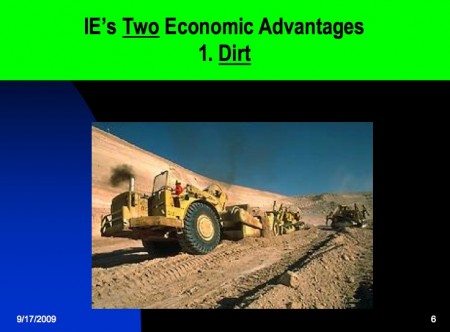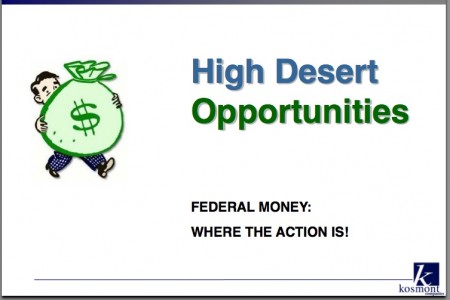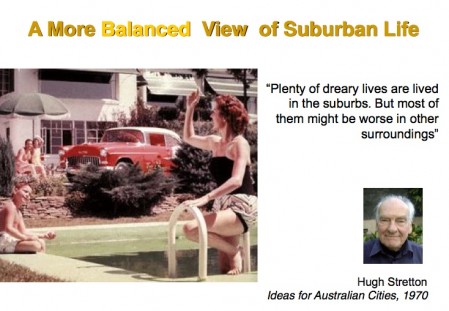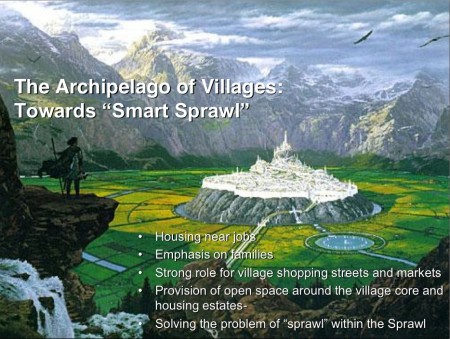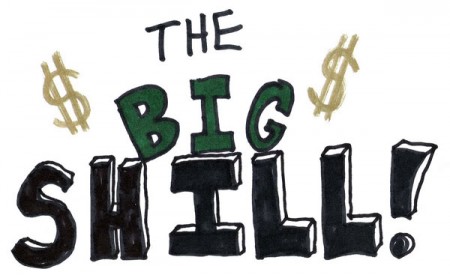

VICTORVILLE, CA—Following the general trend seen all over the country, there’s been a push around these parts to convince people that the recession will soon be a thing of the past. Local papers have been publishing articles with laughable headlines like “SoCal housing market may be stabilizing” or “Local economy back in growth mode.” Meanwhile, the city of Victorville has been abandoning non-mission-critical development projects, raising utility fees and borrowing from itself like mad to keep a few core development projects afloat to, you know, keep up appearances. Last week, community elders pulled together a who’s who of obscure shills for the 10th Annual High Desert Economic summit, hoping that a pep talk and some community time will help shake out the recession blues.
The Daily Press dedicated a whole series of articles to this event, starting with this announcement:
International economist says High Desert can bounce back
September 08, 2009 5:31 PM
PATRICK THATCHER Staff WriterVICTORVILLE • An internationally known economist who specializes in economic trends says that the High Desert will eventually turn the corner and get back on its feet — but probably not through industries that have driven it in the past.
“What happened to Victorville and Apple Valley and those places as a whole is something we have to look at as a way to re-invent themselves and basically look at how you re-align your economy,” said Joel Kotkin, an international authority on economic, global, political and social trends.
Kotkin is the keynote speaker at the 10th annual High Desert Red Cross Economic Summit on Thursday, where he said he’ll attempt to address the questions: “How did you get in this mess, and how do you get out of it?”
The name Joel Kotkin didn’t ring a bell for me, neither did John Husing, Ph.D., Larry J. Kosmont or any of the other speakers lined up for the event. But I’m still new and haven’t familiarized myself with every “expert” tasked with fluffing up the region’s economic optimism. I did recognize one of the panelists, though: County Supervisor Brad Mitzlefelt. He’s a classic example of the bumbling sleaze that inhabits the local McHalls of Power. Dopey and bearded, Mitzlefelt was the handpicked successor of former Supervisor Bill Postmus, the rising local Republican star who crashed and burned in a magnificent fireball of destruction, the kind that only repressed conservatives manage to pull off.
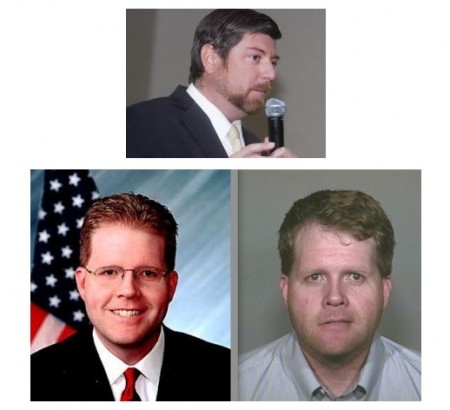
Brad Mitzelfelt (top), Bill Postmus: Before & After (bottom)
Last year, Postmus was investigated for corrupt dealings with real estate developers but was arrested for possession of a controlled substance, which finally outed him as a meth-addled, hopelessly out of control, closeted knob-gobbler. The fallen star was a member of Victorville’s weird, evangelical Jesus-rock High Desert Church by day who would by night commute to the gay hot spots in Hollywood, Palm Springs and Laguna Beach to smoke meth and safely party where no one would recognize him, reported the San Bernardino Sun.
So the conference looked like it had potential, but I couldn’t make it there. And now I regret it. Because having looked over a couple of the PowerPoint presentations put together by its panel of economic gurus, it’s obvious the event must have been one hell of a howler. Here are a few economic revitalization policy recommendation highlights I could glean from their material:

Economist Dr. John Husing, pictured here “making first contact with a lost tribe from the stone age.”
(Check out Husing’s Indiana Jones adventures Web site…)
I’ll start with Dr. John Husing, a “private economist” who specializes in the Inland Empire, because he is unrivaled in his unflinching boosterism and deserves first-class treatment. Just look at this man’s track record:
In 2006, he predicted that Inland Empire was “right on the cusp of a very powerful period in job growth. . . . Is the housing market vulnerable? Yes, it is. But is a bubble likely to happen? No, it is not. The underlying strength of our economy is too great.” In 2007, he doubled down on the optimism: “Historically speaking, the doldrums surrounding the housing market are not as serious as they appear.” In 2008, he pawned his watch, his pinkie ring, and his insect collection and went all in, saying that does not believe “homes ever again will be as affordable as they were in 2000” and that we were entering a “chronic shortage of supply” that will push up prices forever.
Now, in 2009, his zeal has not been blunted one bit. To Dr. Husing, the High Desert had two economic strengths over the competition: dirt and blue collar labor. One of his slides contained a graph showing that San Bernardino County had the highest levels of low education in Southern California, meaning 50.9% of the workforce had nothing more than a high school diploma. And that was a good thing. Something to be proud of and to cultivate because it provided a large work force to lure in manufacturing businesses. But he contradicted himself a few slides later when he started pontificating that America was no longer in the manufacturing business. These days, it was all about service and transportation. Did that mean the High Desert was on its way to becoming a prosperous community of minimum-wage burger flippers, truck drivers, fork lift operators and an upper class made up of prison guards, who would be pulling three times the average minimum wage a slave could make? Actually, yes. It’s already starting to look that way.
Husing admitted that things were bad, but there was a bright light at the end of the tunnel, and it was real estate. Here’s how it would work according to the expert: economic collapse had shot housing affordability sky high (about as affordable as it was in 1999), which in turn created a huge increase in demand and drove up prices. Furthermore, for the past decade, Southern California had not been building enough dwellings to satisfy demand, with the deficit has been running to the tune of 15,670 single family homes a year. That’s right, the industry did not overdevelop. All those empty houses, well, they don’t exist. The next few phases are very logical: lower home values had led to an increase in demand for homes, yet there are not enough homes to meet that demand. But the High Desert has a lot of empty homes, and they are some of the cheapest around. Therefore, people will flock to the High Desert to buy homes, thereby raising real estate values and bringing business and tax revenue with them. That is why Victorville is about to start turning prosperous. Q.E.D.
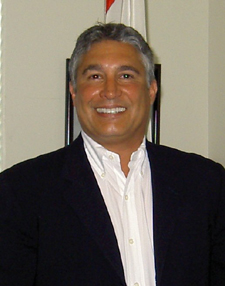
Mr. Kosmont, CRE
Next up were the slides prepared by Larry J. Kosmont, CRE. He’s a high profile real estate consultant and a member of an elite unit within the National Association of Realtors, an honor that allows him to proudly bear the title of “Counselor of Real Estate,” or CRE, next to his name, which he does. A CRE is the Ph.D. of the dirt merchant class. “Membership Means Access,” says a brochure for prospective applicants. “In today’s world of global investment flows, access to the major institutions and funds in the USA is crucial and this is facilitated through the CRE.” How do you get into the club? Well, first you have to hand over a one-time membership fee of $2,500 and then pony up another $1,500 every year thereafter. With this kind of connectedness, Mr. Kosmon, CRE, created the slickest-looking PowerPoint presentation of the bunch, hands down. (Actually, two assistants put it together for him.)
Mr. Kosmont, CRE, outlined a three-pronged attack to beat back the recession in the High Desert. They needed to boost real estate values, increase retail/hotels to draw tax revenue and promote corporate expansion into the area. Now, with the economy being as bad as it is, Kosmon admitted that there was really only one way to actually do that: ask the federal government for money. “Follow the public money,” he wrote. “Keep an eye on your business and an eye out for the federal, state, and local programs that could help your bottom line.” To bring that point home, Kosmont has a slide showing a Clip Art drawing of a little man in a suit carrying huge bag of money and this not so subtle message taking up most of the page:
Kosmont then made a bunch of nonsensical statements. Like this one, for example: “Be keenly aware of Generational Shift in end users of goods and services. Boomers are retiring and Gen-Y is becoming prominent consumers.” Or this one: “Change management will be key. The urgency is here. Adaptability will take foresight and a stomach for risk.” It was clear he was just taking up space and time, keeping busy in front of his geriatric audience that was probably being wowed by his PowerPoint presentation’s animated slide transitions. But in the end, Kosmont’s professional packaging was no match for Dr. Husing’s booster masterpiece, which helps explains why the Good Doctor is one of the most frequently quoted “economists” around these parts.
Now we move on to Joel Kotkin, an “international authority on economic, global, political and social trends” and the star of the show.
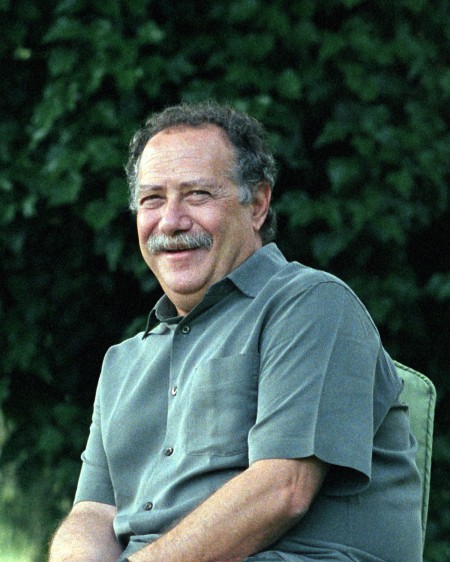
Joel Kotkin: author, futurist, thinker and expert on suburban growth
Seeing how Kotkin was a “international authority”, I did a little research on the man. One attendee told me that Kotkin identified himself as a Democrat at the conference, yet he had a dark streak of Reagan worship running through his “work” as a pro-business, pro-growth think-tanker. The man’s been known to defend Reagan and whip himself up into an anti-regulation, anti-liberal froth, alarming the good citizens of suburbia that city planners will take away people’s homes and forcefully relocate them to apartments, if given free reign. But there’s more: not only will they kill the US economy with their centrally-planned poison, but regulation of suburban growth has been proven to cause a decline in birthrates, meaning that city planning literally endangers the very future of America.
But he didn’t inject any of that into his PowerPoint slides. His message was simple and direct: expand the suburbs to the max, empty out the cities, deregulate the economy and remember to leave some space between the tracts for factories, warehouses and whatever else the Invisible Hand, in its infinite wisdom, decides to bless us with. Kotkin is fanatical about horizontal growth. He believes the city is dead and the future lies with suburbia. He loves the sprawl and wants it to spread all over the land like a mold. (I guess that would make him a proponent of pan-urbia, if I may coin a term.)
From what I understand, Kotkin fancies himself a futurist, but the only futurising he does in his presentation is to rehash a few dot-com bubble cliches about how telecommuting is going to revolutionize our lives and our commutes. He’s got a couple of sci-fi quotes floating around to bolster his pan-urbia theory of sprawl:
“Town” and “city‟ will be, in truth, terms as obsolete as “mail coach.”
—H.G. Wells, Anticipations of the Mechanical & Scientific Progress Upon Human Life and Thought (1902)
“The future is already here. It’s just not equally distributed yet.”
—William Gibson author, coined term cyberspace
In slide after slide, he says that suburban life is the pinnacle of modern living. It is not the “brain dead land of ‘Desperate Housewives'” or a “kind of sprawling dystopia” that some make it out to be. He takes us back to the suburban ideal of the 50s with a retro photograph of an idyllic scene: a young mother getting out of her own pool, with a bright red new car in the background, parked right in front of her big new house. The whole family is in the shot, smiling vacant, joker nitrous oxide grins.
But that’s the past. The future, as he shows on a slide with a cheese-ball painting of a fantasy city, is all about “smart sprawl”.
Ain’t that a perty picture? Don’t “village shopping streets and markets” sound nice? Well, I wouldn’t be fooled by Kotkin’s cute, community-oriented rhetoric. If there’s anything in that slide that should be paid attention to, it’s the “archipelago” he’s got up there in the title. No matter how Kotkin phrases it, his vision of a suburban utopia involves a sprawling network tract-home settlements crammed with people ensnared into lifelong mortgage debt.
But as evil as his agenda may be, Kotkin’s presentation was a disappointment, turning out to be the dullest of all the PowerPoints. His faux-intellectualism was no match for Dr. Husing’s wacky economic theories, which helped propel the Doc to the rank of “Low-rent Booster Champion of the High Desert.”
Shill on, you old shiller.

Photo courtesy of www.johnhusing.com
